 W
WThe Potomac River is found within the Mid-Atlantic region of the United States and flows from the Potomac Highlands into the Chesapeake Bay. The river is approximately 405 miles (652 km) long, with a drainage area of about 14,700 square miles (38,000 km2). In terms of area, this makes the Potomac River the fourth largest river along the Atlantic coast of the United States and the 21st largest in the United States. Over 5 million people live within the Potomac watershed.
 W
WThe South Branch Potomac River has its headwaters in northwestern Highland County, Virginia near Hightown along the eastern edge of the Allegheny Front. After a river distance of 139 miles (224 km), the mouth of the South Branch lies east of Green Spring in Hampshire County, West Virginia where it meets the North Branch Potomac River to form the Potomac.
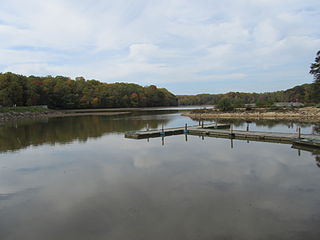 W
WLake Accotink is a reservoir in North Springfield in Fairfax County, Virginia, United States. Lake Accotink is formed by the damming of Accotink Creek. The lake is surrounded by Lake Accotink Park.
 W
WLake Anne is a reservoir in the unincorporated suburban community of Reston in Fairfax County, Virginia, United States. The lake is part of the Difficult Run drainage area of the county.
 W
WLake Artemesia is a man-made lake in Prince George's County, Maryland, located within the Lake Artemesia Natural Area in College Park and Berwyn Heights. The lake covers an area of 38 acres (150,000 m2), and the surrounding natural area is administered by Maryland-National Capital Park and Planning Commission and includes aquatic gardens, fishing piers, and hiker-biker trails.
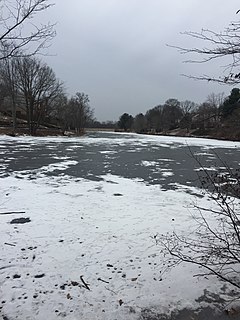 W
WLake Braddock is a reservoir in the community of Burke in Fairfax County, Virginia, United States. Lake Braddock is created by an impoundment on a tributary stream of Pohick Creek, itself a tributary of the Potomac River.
 W
WBreckenridge Reservoir is a small reservoir on Chopawamsic Creek in Prince William and Stafford counties, Virginia. The reservoir's western shore is the Marine Corps Base Quantico and the eastern shore is a part of Prince William Forest Park, which is a unit of the National Park Service. The reservoir is open to fishing along with a Virginia fishing license and Marine Corps Base Quantico permit. Primitive campsites and a hiking trail are on the Prince William Forest Park side of the reservoir. Reservoir storage volume is approximately 22,500,000 cubic feet with a surface area of about 1,820,000 square feet.
 W
WBrushy Fork Lake is an 18-acre (7 ha) impoundment on the South Branch South Fork Potomac River located three miles (5 km) south of Sugar Grove in southeastern Pendleton County, West Virginia, United States. Brushy Fork Lake lies in the Dry River District of the George Washington National Forest.
 W
WBurke Lake is a 218 acres (88 ha) freshwater reservoir in Fairfax Station, Fairfax County, Virginia, United States. It is contained within Burke Lake Park, a Fairfax County public park owned by the Fairfax County Park Authority (FCPA). Burke Lake is formed by a dam on South Run, a tributary stream of the Potomac River.
 W
WBuzzard Point is an urbanized area located on the peninsula formed by the confluence of the Potomac and Anacostia Rivers in the southwest quadrant of Washington, D.C., United States.
 W
WThe Chesapeake and Ohio Canal, abbreviated as the C&O Canal and occasionally called the "Grand Old Ditch," operated from 1831 until 1924 along the Potomac River from Washington, D.C., to Cumberland, Maryland. The canal's principal cargo was coal from the Allegheny Mountains.
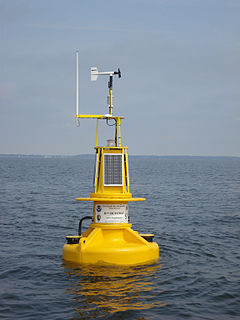 W
WChesapeake Bay Interpretive Buoy System (CBIBS) is a network of observational buoys that are deployed throughout the Chesapeake Bay to observe the estuary's changing conditions and to serve as way points along the Captain John Smith Chesapeake National Historic Trail. They are maintained by the United States National Oceanic and Atmospheric Administration (NOAA). These "smart buoys" observe and record meteorological, oceanographic and water quality data which can be obtained in real-time by calling 1-877-BUOY-BAY or by logging on to http://buoybay.noaa.gov/. CBIBS is an operational buoy system in the Chesapeake Bay dedicated to maintaining a broad range of measurements necessary to track Bay restoration progress.
 W
WCuller Lake is a man-made lake in Frederick, Maryland. The lake is used as part of stormwater management and it is also a gathering place for community recreation. The lake was restored and revitalized in 2016. The lake is located in Baker park.
 W
WDalecarlia Reservoir is the primary storage basin for drinking water in Washington, D.C., fed by an underground aqueduct in turn fed by low dams which divert portions of the Potomac River near Great Falls and Little Falls. The reservoir is located between Spring Valley and the Palisades, two neighborhoods in Northwest Washington, and Brookmont, a neighborhood in Montgomery County, Maryland.
 W
WDyke Marsh is a freshwater wetland and wildlife preserve located on the west bank of the Potomac River south of Alexandria, Virginia between Old Town Alexandria and Mount Vernon. Dyke Marsh consists of about 380 acres (1.5 km2) of tidal marsh, floodplain, and swamp forest. It formed 5,000 to 7,000 years ago. With a total size of 485 acres, Dyke Marsh is one of the largest remaining pieces of freshwater tidal wetlands left in the Baltimore-Washington Metropolitan Area. The marsh is managed by the National Park Service as part of the George Washington Memorial Parkway. Dyke Marsh contains a wide array of plant and animal life. "Haul Road" is a trail that leads visitors into the marsh. It is frequented by area birdwatchers. Dyke Marsh is located off the George Washington Memorial Parkway at the Belle Haven Marina exit.
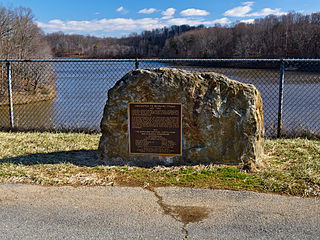 W
WLake Bernard Frank, is a 54-acre (220,000 m2) reservoir on the North Branch of Rock Creek in Derwood, Maryland, U.S., just east of Rockville. In the late 1960s it was renamed after Bernard Frank, a wilderness activist and a co-founder of The Wilderness Society. The lake's boundaries are, approximately, Route 28, East Gude Drive, Avery Road, and Muncaster Mill Road. Lake Frank was created in 1966 as Lake Norbeck to aid in flood and sediment control, as well as to provide recreation. It has an earthen dam, installed in 1967, on its southern side. It was created as a sister lake to Lake Needwood. Lake Frank is owned by the Maryland-National Capital Park and Planning Commission (M–NCPPC).
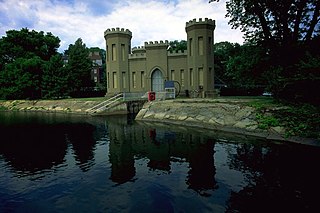 W
WThe Georgetown Reservoir is a reservoir that is part of the water supply and treatment infrastructure for the District of Columbia. It is located in the Palisades neighborhood of Washington, D.C., approximately two miles downstream from the Maryland–D.C. boundary.
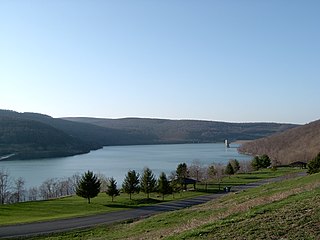 W
WJennings Randolph Lake is a reservoir of 952 acres (3.85 km2) located on the North Branch Potomac River in Garrett County, Maryland and Mineral County, West Virginia. It is approximately eight miles upstream of Bloomington, Maryland, and approximately five miles north of Elk Garden, West Virginia.
 W
WKingman Lake is a 110-acre (0.45 km2) artificial lake located in the Anacostia River in Washington, D.C., in the United States. The lake was created in 1920 when the United States Army Corps of Engineers used material dredged from the Anacostia River to create Kingman Island. The Corps of Engineers largely blocked the flow of the Anacostia River to the west of Kingman Island, creating the lake. Kingman Lake is currently managed by the National Park Service.
 W
WLittle Seneca Lake is a reservoir located near the Boyds community in Montgomery County, Maryland.
 W
WLittle Stony Creek is a 6.8 mile long river in the George Washington and Jefferson National Forests in the Commonwealth of Virginia. It is a first-order tributary of the North Fork Shenandoah River and the Potomac River.
 W
WThe McMillan Reservoir is a reservoir in Washington, D.C. that supplies the majority of the city's municipal water. It was originally called the Howard University Reservoir or the Washington City Reservoir, and was completed in 1902 by the U.S. Army Corps of Engineers. The reservoir was built on the site of Smith Spring, one of the springs previously used for drinking water. Washington's earliest residents relied on natural springs but this came to be inadequate as the city's population grew. In 1850, Congress determined that the Potomac River should be the city's principal source of water.
 W
WMount Storm Lake – also known as New Stony River Reservoir – is a 1,200 acres (4.9 km2) reservoir created in 1965 on the Stony River in Grant County, West Virginia. It serves as a cooling pond for the Dominion 1.6 gigawatt Mount Storm Power Station, which provides electricity to more than two million customers in Northern Virginia. The reservoir stands at an altitude of 3,244 feet (989 m).
 W
WLake Needwood is a 75-acre (300,000 m2) reservoir in Derwood, Maryland, United States. Located east of Rockville, in the eastern part of Montgomery County, it is situated on Rock Creek. The lake was created by damming Rock Creek in 1965 with the goal of providing flood control and reducing soil erosion. Lake Needwood also protects the water quality of the creek by functioning as a retention basin to trap sediment from storm-water runoff.
 W
WThe Patowmack Canal is a series of five inoperative canals located in Maryland and Virginia, United States, that was designed to bypass rapids in the Potomac River upstream of the present Washington, D.C. area. The most well known of them is the Great Falls skirting canal, whose remains are managed by the National Park Service as it is within Great Falls Park Virginia, an integral part of the George Washington Memorial Parkway.
 W
WThe Potomac Company was created in 1785 to make improvements to the Potomac River and improve its navigability for commerce. The project is perhaps the first conceptual seed planted in the minds of the new American capitalists in what became a flurry of transportation infrastructure projects, most privately funded, that drove wagon road turnpikes, navigations, and canals, and then as the technology developed, investment funds for railroads across the rough country of the Appalachian Mountains. In a few decades, the eastern seaboard was crisscrossed by private turnpikes and canals were being built from Massachusetts to Illinois ushering in the brief seven decades of the American Canal Age. The Potomac Company's achievement was not just to be an early example, but of being significant also in size and scope of the project, which involved taming a mountain stream fed river with icing conditions and unpredictable freshets (floods).
 W
WSeneca Creek State Park is a public recreation area encompassing more than 6,300 acres (2,500 ha) along 14 miles of Seneca Creek in its run to the Potomac River in Montgomery County, Maryland. The park features facilities for boating and fishing as well as trails for hiking, cycling, and horseback riding. It is managed by the Maryland Department of Natural Resources.
 W
WSleepy Creek Lake is a 205-acre (0.8 km2) impoundment of the Meadow Branch of Sleepy Creek in Berkeley County in West Virginia's Eastern Panhandle. The reservoir is located entirely within the Sleepy Creek Wildlife Management Area.
 W
WStony River Reservoir was constructed on the Stony River in 1888 by Westvaco to supply the source of water for the company's main pulp mill. William Luke's summer residence was located on the lake. The dam suffered from structural weakness and was periodically drained for repairs. The center portion of the dam has since been demolished and the reservoir drained. The majority of the dam still stands on either side of the, now, free flowing river.
 W
WThe Tidal Basin is a partially man-made reservoir between the Potomac River and the Washington Channel in Washington, D.C. It is part of West Potomac Park and is a focal point of the National Cherry Blossom Festival held each spring. The Jefferson Memorial, the Martin Luther King Jr. Memorial, the Franklin Delano Roosevelt Memorial, and the George Mason Memorial are situated adjacent to the Tidal Basin. The basin covers an area of about 107 acres (43 ha) and is 10 feet (3.0 m) deep.
 W
WTrout Pond — formerly called Old Pond — located near Wardensville in Hardy County, West Virginia, USA, is the state's only natural lake. The small "lake" is situated in the Trout Pond Recreation Area (TPRA) of the George Washington National Forest. Formerly, the pond had fluctuated in surface area between 2 and 3 acres, but recently it has appeared to be disappearing due to underground structural changes.
 W
WWarden Lake is a reservoir on Moores Run near Wardensville in northern Hardy County, West Virginia, United States. Warden Lake is located within the Warden Lake Wildlife Management Area nestled between Baker Mountain and Big Ridge.
 W
WThe Washington Aqueduct is an aqueduct that provides the public water supply system serving Washington, D.C., and parts of its suburbs. One of the first major aqueduct projects in the United States, the Aqueduct was commissioned by Congress in 1852, and construction began in 1853 under the supervision of Montgomery C. Meigs and the US Army Corps of Engineers. Portions of the Aqueduct went online on January 3, 1859, and the full pipeline began operating in 1864. The system has been in continuous use ever since. It is listed as a National Historic Landmark, and the Union Arch Bridge within the system is listed as a Historic Civil Engineering Landmark.
 W
WThe Washington Channel is a channel that parallels the Potomac River in Washington, D.C. It is located between the Southwest Waterfront on the east side and East Potomac Park on the west side. The channel is two miles (3.2 km) long, receives outflow from the Tidal Basin at its north end, and empties into the Anacostia River at Hains Point at its south end. The channel's depth ranges from 8.8 feet (2.7 m) to 23 feet (7.0 m).
 W
WThe Washington City Canal operated from 1815 until the mid-1850s in Washington, D.C. The canal connected the Anacostia River, termed the "Eastern Branch" at that time, to Tiber Creek, the Potomac River, and later the Chesapeake and Ohio Canal (C&O). The canal became disused during the late 19th century and the city government covered over or filled in various sections in 1871.
 W
WZekiah Swamp is part of the Potomac River basin in Charles County, Maryland in the United States. The swamp is 21 miles (34 km) of braided stream stretching the length of Charles County and is a tributary of the Potomac River. It sits at an elevation of three feet (0.91 m) and 450 acres (180 ha) of its southern end is protected as the Zekiah Swamp Natural Environment Area. The Maryland Department of Natural Resources has the authority to purchase an additional 5,000 acres (2,000 ha) for the park. Charles County has moved to protect an additional 65,000 acres (26,000 ha) of the wetland. The headwaters of the swamp are protected as part of Cedarville State Forest. It was first accurately surveyed by John Henry Alexander, Maryland's official cartographer, in 1835, as "Allen's Fresh".